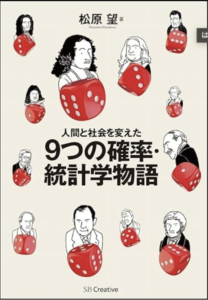Nine Stories of Probability and Statistics That Changed Humans and Society Reading Notes
From Nine Stories of Probability and Statistics That Changed Humans and Society

Chapter 1: Probability began as a bet – Pascal Fermat
Chapter 2: The Ease of Being Right is Measurable – Jacob Bernoulli
the art of guessing
The Art of Counting
If you can enumerate all the things that happen as permutations and combinations, you can guess
Calculate all of them at once by stacking them on top of each other
Bernoulli distribution
Distribution that takes 1 with probability p and 0 with probability q=1-p
Bernoulli Trial
Only one of A or B can happen.
Either Yes or no can only happen
Either the front or back side can only happen
Bernoulli process
Bernoulli trials that are independent and have the same probability distribution
Chapter 3: An interesting problem that developed probability theory – de Moivre
The Theory of Chance.”
Chance is not equal to small probability
Measuring chance in terms of probability
(1-1/n)n is 0.36789…, (1+1/n)n is 2.7182 and the bottom of the natural logarithm
Inclusion principle
Binomial distribution
Discrete probability distribution represented by the success of n independent trials that are either successes or failures
The probability of success p in each trial is constant (Bernoulli trials)
Approximation of binomial distribution
Normal distribution
Binomial distribution approaches normal distribution under certain conditions
Poisson distribution
Chapter 4: The Law of Cause and Effect – Bayes
How is chance determined?
Given the number of times an event with unknown probability occurs or fails to occur, respectively
Consider the conditional probability that probability (x) is in the range x1<x<x2 under “event happened a times and didn’t happen b times
P(x1<x<x2|a happened and b did not happen)=∮xa(1-x)bdx/∮xa(1-x)bdx
Approach by area
Probability
Drop a ball at random, its position x
If subsequent people drop by x, event m occurs, if not, it does not
Drop N balls, and assume that a is M and b is not M
Only a and b are known and we know where x is
We can weight them.
Bayes’ theorem
Let H1,H2…,Hk be mutually exclusive causes in k ways
Let P(Hi) be the prior probability of Hi
P(B|Hi) is the probability of outcome B under the conditions under which Hi occurred
P(Hi|B) is the probability (posterior probability) that the cause is Hi under the conditions under which B occurred
P(Hi|B)=P(Hi)P(B|Hi)/(P(H1)P(B|H1)+P(H2)P(H2)P(B|H2)… P(Hk)P(B|Hk))
EXAMPLE.
When three bags, H1, H2 and H3, contain a red ball and a white ball in the ratio of 3:1, 1:1 and 1:2, respectively, and the red ball is pulled out, the probability of each bag is
Hn: extracted from jar Hn, R: red ball extracted
P(H1|R)=P(H1)P(R|H1)/P(R)
P(R)=P(H1)P(R|H1)/P(H1|R)=1/3×3/4+1/3×1/2+1/3×1/3=19/36
P(H1|R)=9/19, P(H2|R)6/19, P(H3|R)=4/19
Generalization of Bayes Theorem
The prior probability P(Hi) can be arbitrary, often employing equal probabilities
The denominator of Bayes’ theorem is complicated but common and can be labored
Chapter 5: Completion of Classical Probability Theory and New Departures – Laplace
Chapter 6: Predictions of Data Surprised Even Astronomers – Gauss
Chapter 7: The Founders of Statistical Theory – Ketley Gorton
Chapter 8: The Birth of Modern Probability Theory – Kolmogorov
Chapter 9 “Strategies” that do not risk a hundred battles without knowing your opponent – Von Neumann, Waldo, Sabezis, Keynes


コメント